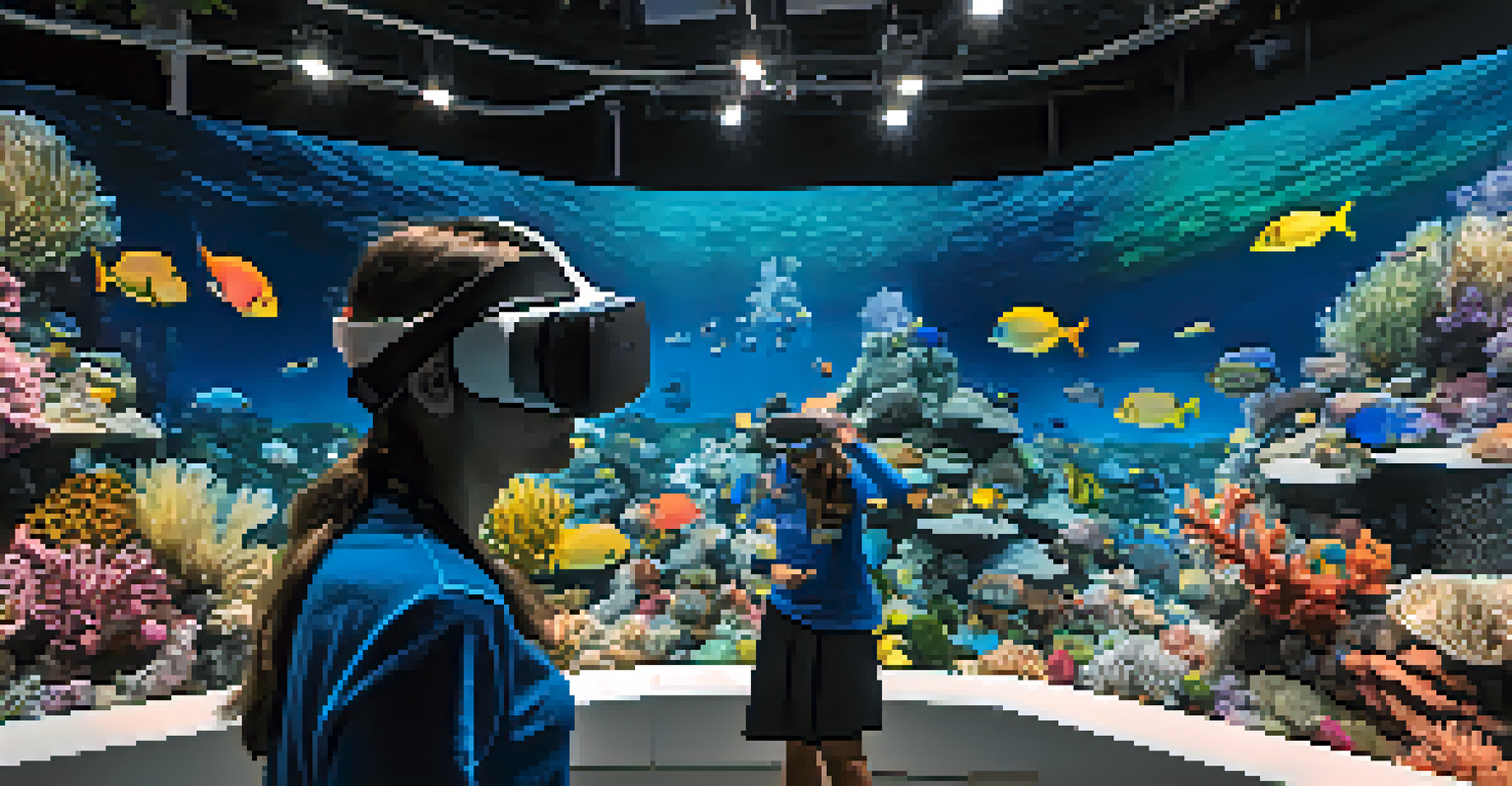The Future of Art in a Warming World: Predictions and Trends

The Intersection of Art and Climate Change Awareness
Art has always been a reflection of society, and as climate change becomes a pressing issue, artists are increasingly using their work to raise awareness. From powerful installations to evocative paintings, creators are expressing the urgency of environmental issues. This trend not only highlights the impact of climate change but also encourages dialogue about sustainability and conservation.
Art is a reflection of society, and as climate change becomes a pressing issue, artists are increasingly using their work to raise awareness.
For example, artists like Olafur Eliasson create immersive installations that engage viewers with natural phenomena, prompting them to reflect on their relationship with the environment. Similarly, street artists are leveraging murals to address local environmental concerns, making art a catalyst for community action. As we move forward, we can expect to see more artists tackling climate themes head-on.
This intersection of art and environmentalism is not just about awareness; it's also about inspiring change. By engaging audiences emotionally, artists can motivate individuals and communities to take action and adopt more sustainable practices. As we navigate a warming world, art will continue to play a crucial role in shaping public perception and inspiring a collective response.
Digital Art: The Role of Technology in Environmental Messaging
As technology advances, digital art is becoming a powerful medium for communicating environmental issues. Artists are utilizing virtual reality and augmented reality to create experiences that immerse viewers in the realities of climate change. This innovative approach not only captivates audiences but also leaves a lasting impression that traditional art forms may struggle to achieve.

For instance, virtual reality experiences can simulate rising sea levels or deforestation, allowing users to witness potential futures firsthand. This kind of engagement can foster a deeper understanding of the consequences of climate change, making the issue more personal and immediate. Moreover, digital art can reach a global audience, breaking geographical barriers and spreading awareness far and wide.
Art Raises Climate Change Awareness
Artists use their work to engage audiences in conversations about environmental issues and inspire action towards sustainability.
In the future, we can expect more artists to embrace digital platforms, using them as tools for activism and education. As our world becomes increasingly interconnected, digital art will serve as a vital medium for storytelling and advocacy, shaping the narrative around climate change in ways we have yet to fully realize.
Sustainable Practices in Art Creation
As awareness of environmental issues grows, so does the movement towards sustainable art practices. Artists are actively seeking eco-friendly materials and processes to minimize their environmental footprint. This shift not only addresses climate change but also challenges the art community to rethink traditional methods of creation.
Through art, activists can communicate complex ideas in an accessible and relatable manner.
For example, some artists are experimenting with biodegradable materials or repurposing waste to create stunning works of art. This not only reduces waste but also sends a powerful message about the importance of sustainability. As more creators adopt these practices, it could lead to a significant cultural shift within the art world, emphasizing the importance of environmental responsibility.
In the coming years, we can anticipate a rise in art that prioritizes sustainability, encouraging both artists and audiences to consider the ecological impacts of their choices. This movement will not only redefine the production of art but also inspire future generations to create with the planet in mind.
The Role of Art in Climate Activism
Art has always played a pivotal role in social movements, and climate activism is no exception. Artists are increasingly collaborating with environmental organizations to amplify their messages and reach broader audiences. This partnership can lead to powerful campaigns that highlight the urgency of climate change and inspire collective action.
For instance, initiatives like Artivism blend art with activism, using creative expression as a means to mobilize communities and raise funds for environmental causes. These efforts not only raise awareness but also foster a sense of community around the shared goal of combating climate change. Through art, activists can communicate complex ideas in an accessible and relatable manner.
Digital Art Enhances Environmental Messaging
Technology, such as virtual and augmented reality, is being leveraged by artists to create immersive experiences that deepen understanding of climate change.
As climate issues become more pressing, the collaboration between artists and activists will likely intensify. We can expect to see innovative projects that harness the power of creativity to inspire change and encourage grassroots movements, making art an essential tool in the fight for a sustainable future.
Art as a Reflection of Climate Anxiety
In a world increasingly affected by climate change, many artists are expressing their anxieties through their work. This phenomenon, often referred to as climate anxiety, manifests in various artistic forms, from painting to performance art. By channeling their fears and concerns into creativity, artists can articulate the emotional toll of living in a warming world.
For example, artists like Agnes Meyer-Brandis explore themes of ecological collapse and personal helplessness, creating work that resonates deeply with viewers. This reflection of climate anxiety serves not only as a cathartic release for the creator but also connects with audiences who share similar feelings of uncertainty about the future. Through art, these complex emotions can be expressed and explored.
As we move forward, we can expect climate anxiety to continue influencing artistic expression. This trend will likely lead to a richer tapestry of work that encapsulates the emotional landscape of our time, encouraging conversations about mental health, resilience, and hope in the face of adversity.
Emerging Artists: New Voices in Climate Conversations
The next generation of artists is stepping up to address climate change in innovative ways. Many emerging creators are using their platforms to challenge traditional narratives and advocate for marginalized voices in the environmental movement. This fresh perspective is essential for a more inclusive dialogue about climate issues.
For instance, artists from diverse backgrounds are bringing attention to how climate change disproportionately affects vulnerable communities. Their work often highlights social justice in environmentalism, urging audiences to consider the intersectionality of these issues. By amplifying these voices, the art world can foster a more comprehensive understanding of the challenges posed by climate change.
Sustainable Practices in Art Creation
There is a growing movement among artists to adopt eco-friendly materials and methods, reflecting a commitment to reducing environmental impact.
As we look to the future, we can expect to see these emerging artists gaining more visibility and recognition. Their contributions will enrich the broader conversation about climate change, ensuring that the narrative is not only about the environment but also about the people who inhabit it.
The Future of Art Exhibitions in a Warming World
Art exhibitions are evolving in response to climate change, with many curators focusing on themes of sustainability and environmental awareness. This shift is evident in the types of exhibits being showcased, as well as the venues chosen for display. Artists and curators alike are prioritizing eco-friendly practices in their presentations, aligning with a broader commitment to sustainability.
For example, outdoor exhibitions are becoming more popular, allowing art to interact with nature while raising awareness about environmental issues. This approach not only enhances the viewing experience but also creates a direct connection between the artwork and its surroundings. Additionally, virtual exhibitions have gained traction, enabling wider accessibility while reducing the carbon footprint associated with traditional gallery spaces.

Looking ahead, we can anticipate a continued evolution in the way art is exhibited and experienced. This future will likely prioritize sustainability, engagement, and inclusivity—creating a vibrant platform for artists to share their visions of a warming world.